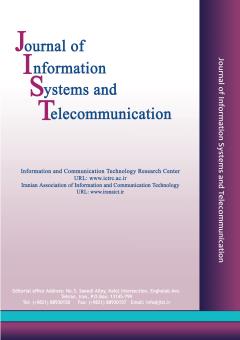Transmission Parameter-based Demodulation in Visible Light Communications using Deep Learning
Subject Areas : Optical Communication
Sarah Ayashm
1
![]() ,
Seyed Sadra Kashef
2
*
,
Seyed Sadra Kashef
2
*
![]() ,
Morteza Valizadeh
3
,
Morteza Valizadeh
3
![]() ,
Hasti Akhavan
4
,
Hasti Akhavan
4
1 - Department of Electrical and Computer Engineering, Urmia University, Iran
2 - Department of Electrical and Computer Engineering, Urmia University, Iran
3 - Department of Electrical and Computer Engineering, Urmia University, Iran
4 - Department of Electrical and Computer Engineering, Urmia University, Iran
Keywords: Demodulation, VLC, Distances, Convolutional Neural Network, ISI,
Abstract :
This paper proposes an innovative approach by employing a one-dimensional Convolutional Neural Network (CNN) for demodulation in VLC systems. The used Data-set is real and available online, providing a robust foundation for analysis. It encompasses modulated signals in seven different modulation types, with 29 transmission distances ranging from 0 to 140 centimeters. By accounting for the varying distances between the transmitter and receiver, the model can more accurately interpret the received signals. Additionally, the study suggests that utilizing memory to learn previous symbols, which is essential for mitigating the effects of inter-symbol interference (ISI), can significantly improve demodulation accuracy. Our results of memory-based demodulation show a better performance in contrast to the previous one (AdaBoost).
[1] V. Chandrasekhar, J. G. Andrews and A. Gatherer, "Femtocell networks: a survey", IEEE Communications Magazine, vol. 46, no. 9, 2008, pp. 59-67. Available: 10.1109/MCOM.2008.4623708.
[2] Qi Bi, G. L. Zysman and H. Menkes, "Wireless mobile communications at the start of the 21st century", IEEE Communications Magazine, vol. 39, no. 1, 2001, pp. 110-116. Available: 10.1109/35.894384.
[3] H. Ma, L. Lampe and S. Hranilovic, "Integration of indoor visible light and power line communication systems", in 2013 IEEE 17th International Symposium on Power Line Communications and Its Applications, Johannesburg, South Africa, 2013, pp. 291-296, Available: 10.1109/ISPLC.2013.6525866.
[4] J. Luo, L. Fan, and H. Li, “Indoor positioning systems based on visible light communication: State of the art,” IEEE Communications Surveys & Tutorials, vol. 19, no. 4, 2017, pp. 2871-2893.
[5] Z. M. Kassas and T. E. Humphreys, “Observability analysis of collaborative opportunistic navigation with pseudo range measurements”, IEEE Transactions on Intelligent Transportation Systems, vol. 15, no. 1, 2014, pp. 260-273.
[6] H. Huang, A. Yang, L. Feng, G. Ni, and P. Guo, “Artificial neural network-based visible light positioning algorithm with a diuse optical channel”, Chin. Opt. Lett., vol. 15, no. 5, 2017, pp. 050601.
[7] H. Zou, B. Huang, X. Lu, H. Jiang, and L. Xie, “A robust indoor positioning system based on the Procrustes analysis and weighted extreme learning machine”, Trans. Wireless. Comm., vol. 15, 2016, pp. 1252-1266.
[8] M. Önder, A. Akan and H. Doğan, "Neural network based receiver design for Software Defined Radio over unknown channels", 2013 8th International Conference on Electrical and Electronics Engineering (ELECO), Bursa, Turkey, 2013, pp. 297-300, Available: 10.1109/ELECO.2013.6713848.
[9] S. Ma et al., "Signal Demodulation With Machine Learning Methods for Physical Layer Visible Light Communications: Prototype Platform, Open Dataset, and Algorithms", IEEE Access, vol. 7, 2019, pp. 30588-30598, Available: 10.1109/ACCESS.2019.2903375.
[10] H. Hosseinzadeh, F. Razzazi, and A. Haghbin, “Tracking Performance of Semi-Supervised Large Margin Classifiers in Automatic Modulation Classification”, Journal of Information Systems and Telecommunication (JIST), vol. 4, no. 8, 2014, pp. 1.
[11] K. Majeed and S. Hranilovic, "Passive Indoor Visible Light Positioning System Using Deep Learning", IEEE Internet of Things Journal, vol. 8, no. 19, 2021, pp. 14810-14821, , Available: 10.1109/JIOT.2021.3072201.
[12] B. Lin, Q. Lai, Z. Ghassemlooy and X. Tang, "A Machine Learning Based Signal Demodulator in NOMA-VLC", Journal of Lightwave Technology, vol. 39, no. 10, 2021, pp. 3081-3087, Available: 10.1109/JLT.2021.3058591.
[13] Y. Shi, D. Yan, P. Liu, Y. Chen, C. Li and Z. Lu, "A Review of Machine Learning Based Techniques for Demodulation", 2020 IEEE 9th Joint International Information Technology and Artificial Intelligence Conference (ITAIC), Chongqing, China, 2020, pp. 2292-2296, Available: 10.1109/ITAIC49862.2020.9339005.
[14] H. Wang et al., "Deep Learning for Signal Demodulation in Physical Layer Wireless Communications: Prototype Platform, Open Dataset, and Analytics," in IEEE Access, vol. 7, pp. 30792-30801, 2019, Available: 10.1109/ACCESS.2019.2903130.
[15] S. Kiranyaz, T. Ince, and M. Gabbouj, “Real-time patient-specific ECG classification by 1-d convolutional neural networks,” IEEE Transactions on Biomedical Engineering, vol. 63, no. 3, 2015, pp. 664675.
[16] G. Hinton, L. Deng, D. Yu, G. E. Dahl, A.-r. Mohamed, N. Jaitly, A. Senior, V. Vanhoucke, P. Nguyen, T. N. Sainath, et al., “Deep neural networks for acoustic modeling in speech recognition: The shared views of four research groups”, IEEE Signal processing magazine, vol. 29, no. 6, 2012, pp. 82-97.
[17] S.Ayashm, M.Chehel Amirani, & M.Valizadeh, “Analysis of ECG Signal by Using an FCN Network for Automatic Diagnosis of Obstructive Sleep Apnea”, Circuits Syst Signal Process, vol. 41, 2022, pp. 6411–6426. https://doi.org/10.1007/s00034-022-02091-7
[18] X. Yu, M. O. Efe and O. Kaynak, "A general backpropagation algorithm for feedforward neural networks learning", IEEE Transactions on Neural Networks, vol. 13, no. 1, 2002, pp. 251-254, Available: 10.1109/72.977323.

